金星 ALPO-Japan Latest

Venus Image 2023/10/28(UT)
眞島清人,阿久津富夫
Frank J Melillo,Raimondo Sedrani,Antonio Cidadao,Ray Webster,John Boudreau
F.Melillo,K.Mashima,T.Akutsu,R.Sedrani,A.Cidadao,R.Webster,J.Boudreau
 [Frank J Melillo Holtsville NY U.S.A]
[Frank J Melillo Holtsville NY U.S.A]
UTの日付を跨いだUV画像です。シーイング不良で模様ははっきりしませんが移動しているように見受けられます。
これが金星大気の自転によるものかどうか確信が持てませんが・・・
 [眞島清人 : Kiyoto Mashima,Naha,Okinawa,Japan]
[眞島清人 : Kiyoto Mashima,Naha,Okinawa,Japan]
部分月食後、東空の金星です。UV画像にはかなり大きな暗い地域が見られます。
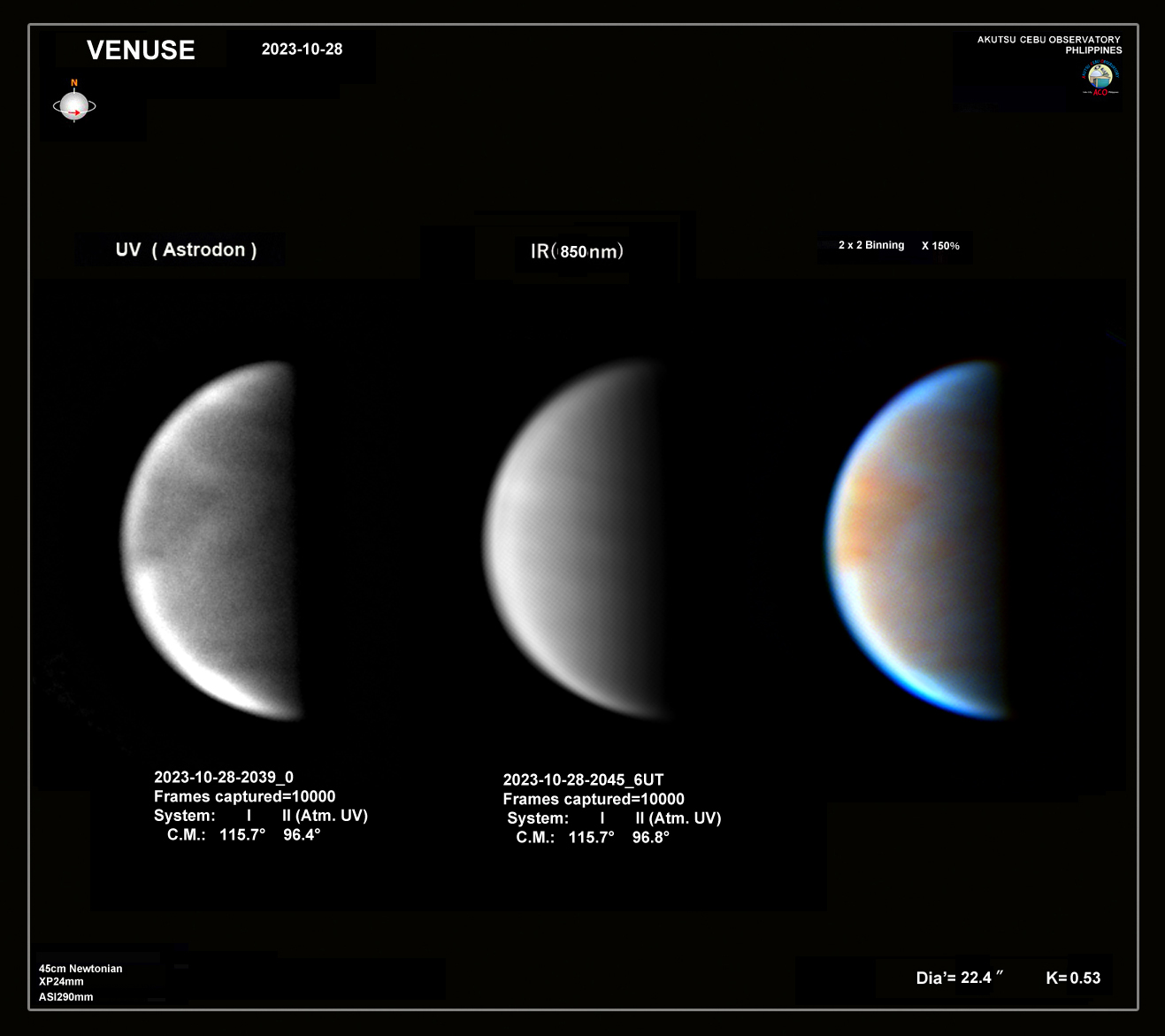 ≪Cebu PHILLIPINES 阿久津富夫≫
≪Cebu PHILLIPINES 阿久津富夫≫
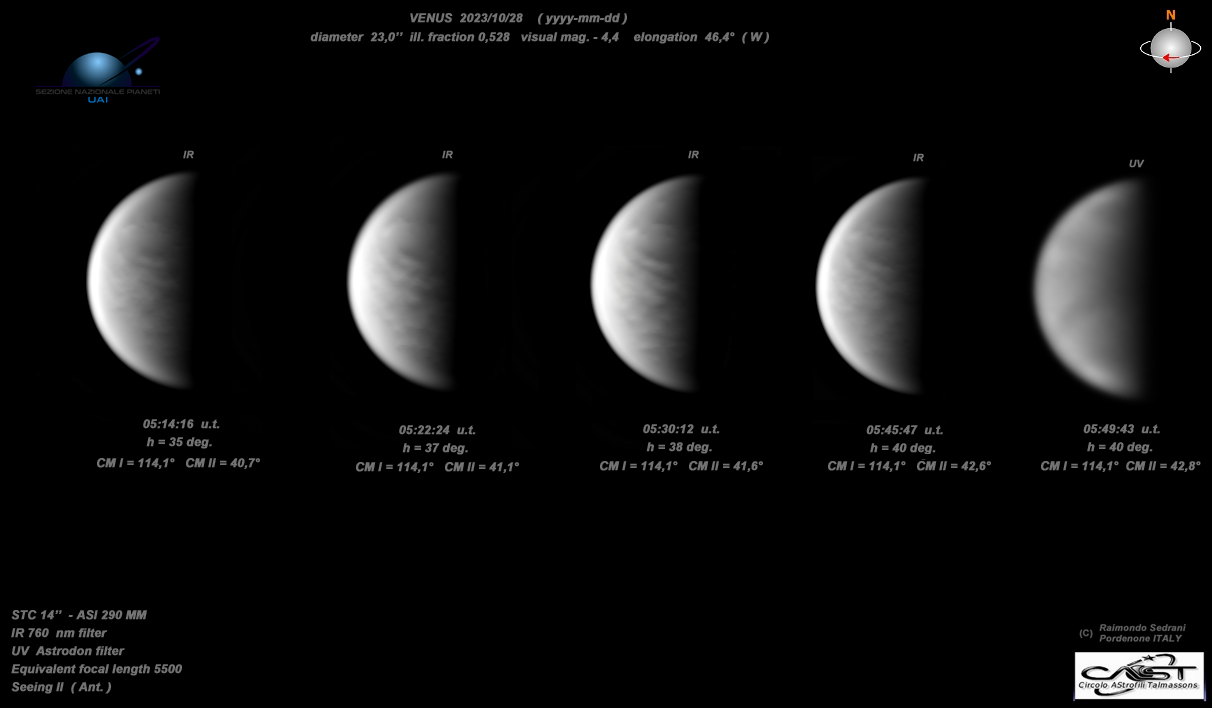
 [Raimondo Sedrani : Pordenone,Italy]
[Raimondo Sedrani : Pordenone,Italy]
I had two periods of clear sky between cloud coverage and rain. I share here the first period where I attempted to image Venus day- and night-side.
I was not prepared with the Pixelteq filter,so I had to use my "old" filter (a 1000nm/20nm filter from IDAS,originally bought as a 1um CH4 band filter) to image the night side. Images "a" to "c" show the three independent 15min SERs that were used to produce the final stacked image "d" (see details on the images). The camera used to get these images was the Neptune 664C,positioned as shown in image "i",and the filter was in the filter wheel #2. Before AS!3,the night side SERs were opened in "SER Player" and processed into grayscale mode and gamma=3 in the "processing tool" of the software. These modified SERs were then saved (as SERs) also in SER Player. This step eased the night side visualization,though the end result was still noisy (this filter has a FWHM of 20nm while the pixelteq is 38nm; also,the central bands differ by 10nm).
To attempt to correlate night-side features with those present in the day-side,I acted on the motorized flip mirror ( see "i") to deviate the light path to a different camera (Mars-M II),which was associated to a filter wheel containing a IR685 filter (and,among others,also a UV filter). I only had time to grab a short 25sec SER before clouds covered the planet (see "e"). Later on (after 4h) I grabbed a routine 5min SER,with better seeing,still with the IR685 filter,just to confirm the markings previously detected (see "f").
Finally,I superimposed the night-side ("d") and day-side ("e") images to probe possible alignment,or continuity,between day-side and night-side features (see "g"). Although there was a small tilt between the two cameras (the day-side terminator is slightly tilted with respect to the night-side sharpening artifact),some hint of continuity is,in my opinion,seen.
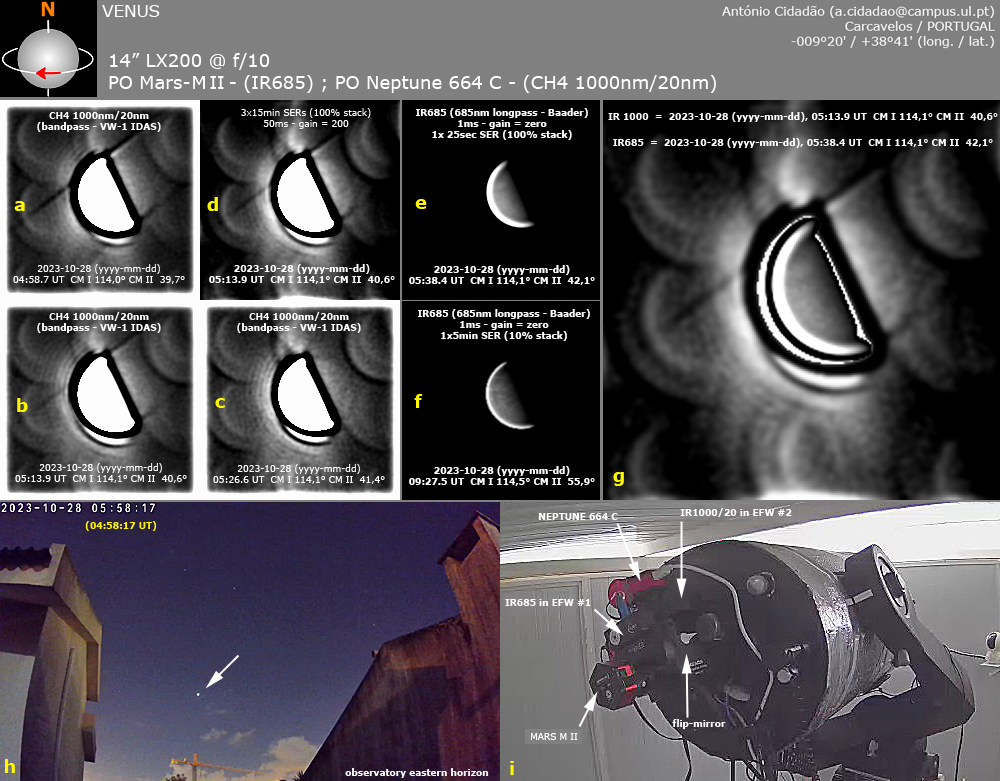 Here is the second part of my observations,where Sloan z'-s' gave the most contrasted mid-altitude cloud features that rotate with time (see gif). The UV image,also obtained with Venus near the meridian,shows some darker areas,bright polar regions,and a brighter cloud,near the limb,at lower latitudes (please take into consideration that strong sharpening was necessary to enhance it.
Here is the second part of my observations,where Sloan z'-s' gave the most contrasted mid-altitude cloud features that rotate with time (see gif). The UV image,also obtained with Venus near the meridian,shows some darker areas,bright polar regions,and a brighter cloud,near the limb,at lower latitudes (please take into consideration that strong sharpening was necessary to enhance it.
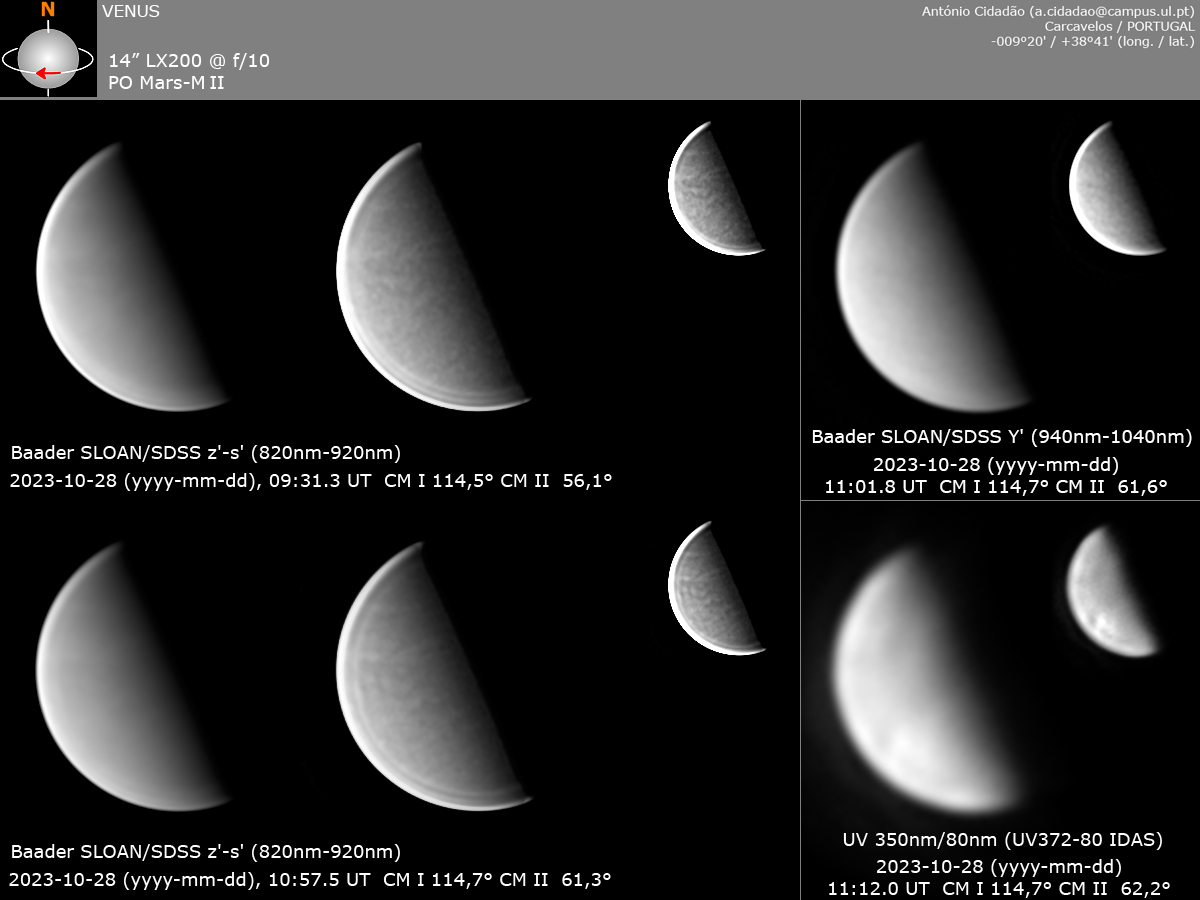
 ≪アントニオ シダダオ ポルトガル≫
[Antonio Cidadao Oeiras - Portugal]
≪アントニオ シダダオ ポルトガル≫
[Antonio Cidadao Oeiras - Portugal]
CMII=75.4,D=22.88
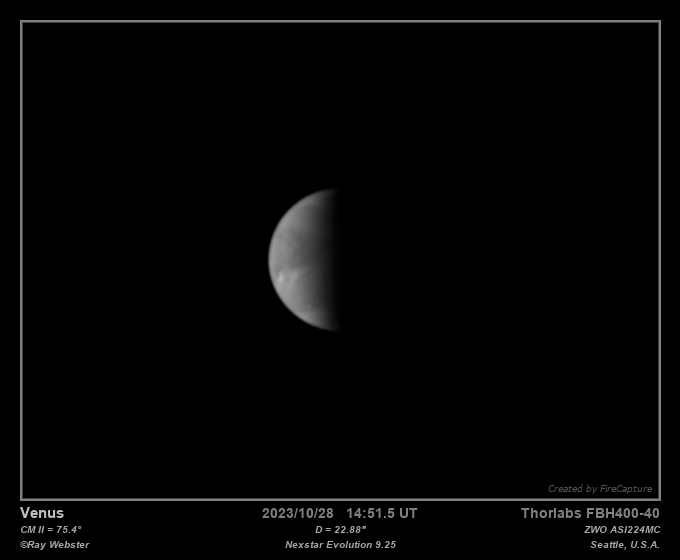 [Ray Webster : Seattle,U.S.A.]
[Ray Webster : Seattle,U.S.A.]
Thermal emission image of the night side at 1.01 micron.
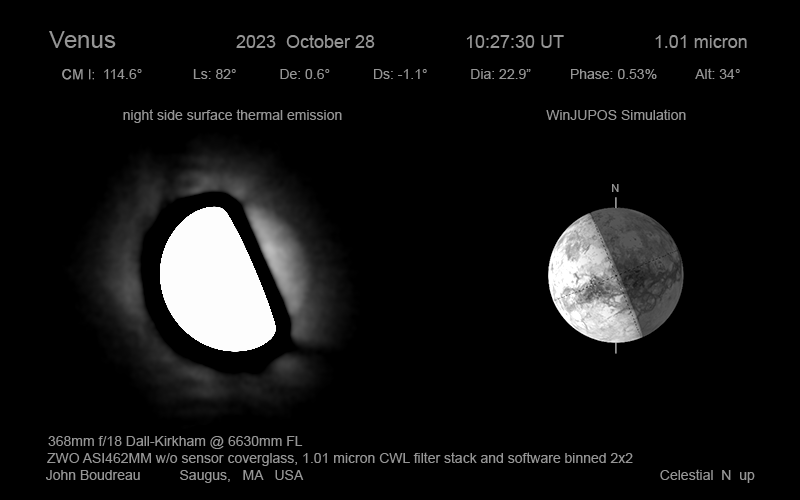 [ John Boudreau,Saugus,MA USA ]
[ John Boudreau,Saugus,MA USA ]


[Frank J Melillo Holtsville NY U.S.A]
[眞島清人 : Kiyoto Mashima,Naha,Okinawa,Japan]
≪Cebu PHILLIPINES 阿久津富夫≫

[Raimondo Sedrani : Pordenone,Italy]
 Here is the second part of my observations,where Sloan z'-s' gave the most contrasted mid-altitude cloud features that rotate with time (see gif). The UV image,also obtained with Venus near the meridian,shows some darker areas,bright polar regions,and a brighter cloud,near the limb,at lower latitudes (please take into consideration that strong sharpening was necessary to enhance it.
Here is the second part of my observations,where Sloan z'-s' gave the most contrasted mid-altitude cloud features that rotate with time (see gif). The UV image,also obtained with Venus near the meridian,shows some darker areas,bright polar regions,and a brighter cloud,near the limb,at lower latitudes (please take into consideration that strong sharpening was necessary to enhance it.

 ≪アントニオ シダダオ ポルトガル≫
[Antonio Cidadao Oeiras - Portugal]
≪アントニオ シダダオ ポルトガル≫
[Antonio Cidadao Oeiras - Portugal][Ray Webster : Seattle,U.S.A.]
[ John Boudreau,Saugus,MA USA ]
 ALPO-Japan Latest
ALPO-Japan Latest

 Venus Section
Venus Section